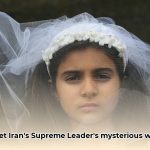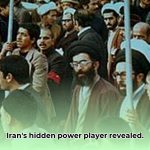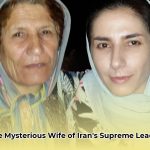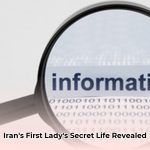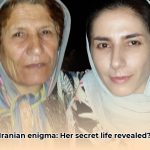Mansoureh Khojasteh Bagherzadeh, the wife of Iran’s Supreme Leader Ali Khamenei, remains an enigmatic figure. While her husband holds immense political power, she has largely remained out of the public eye. This article delves into what is known about her life, piecing together information from various sources to paint a picture of a woman whose role in Iranian society is both fascinating and elusive. From her early life and marriage to her potential involvement in charitable activities, we explore the known facts and address the many unanswered questions surrounding this private yet influential figure. For a more comprehensive biography, see this detailed biography.
The Mystery of Mansoureh Khojasteh Bagherzadeh
Mansoureh Khojasteh Bagherzadeh’s name evokes curiosity. As the wife of Iran’s Supreme Leader, she occupies a unique position within Iranian politics, yet she maintains a remarkably low profile. Gathering information about her is a challenge, with limited publicly available details that invite speculation. However, the available information offers valuable insights into her life, revealing a woman who navigates a complex role with discretion.
Early Life and Family in Mashhad
Mansoureh Khojasteh Bagherzadeh was born in Mashhad, a significant religious center in Iran. While her exact birthdate is debated, with sources suggesting dates between 1945 and 1947, it is generally accepted that she was born into a religious Persian family. Her father, Mohammad Esmaeil Khojasteh Bagherzadeh, was a businessman. She also has a brother, Hassan Khojasteh Bagherzadeh, who formerly held a high-ranking position as the deputy director of IRIB, the state-controlled broadcasting organization. Information about her early education and upbringing is scarce, leaving many questions about her formative years unanswered.
Marriage to Ali Khamenei
In 1964, Mansoureh married Ali Khamenei, a union that would significantly alter the course of her life. Ayatollah Mohammad Hadi Milani officiated their wedding, solidifying the connection between the couple and the religious establishment. At the time of their marriage, Ali Khamenei was an emerging figure in religious and political circles. Mansoureh’s transition from a private citizen to the wife of a prominent leader undoubtedly presented its own set of challenges and opportunities. Together, they have six children: Mostafa, Mojtaba, Masoud, Meysam, Boshra, and Hoda.
Life During the Iranian Revolution
The Iranian Revolution of 1979 dramatically transformed Iranian society and politics. While Ali Khamenei played a crucial role in the revolution and its aftermath, Mansoureh’s involvement during this period remains largely undocumented. Some accounts suggest she actively supported her husband’s activities, providing a safe haven for revolutionary materials and offering unwavering support amidst political turmoil. She reportedly hid rebellious pamphlets and books in her clothing when guards came to arrest her husband in the 1970s. However, detailed information about her specific actions and contributions during this pivotal era is limited.
Supporting War Veterans and Families
Despite maintaining a private life, Mansoureh Khojasteh Bagherzadeh is known for her involvement in charitable and humanitarian activities. She has been associated with efforts to support the families of war veterans and those affected by the Iran-Iraq War. These acts of compassion highlight a commitment to helping those in need, even while maintaining a low public profile. The full extent of her charitable work and its impact on Iranian society remains an area requiring further investigation.
A Deliberately Private Life
Mansoureh Khojasteh Bagherzadeh notably keeps a low profile. She rarely appears in public, especially alongside her husband. Some suggest that this is a deliberate choice, reflecting her personal preferences and a desire to maintain a private life. Others speculate that it may be influenced by cultural norms and expectations surrounding the roles of women in positions of power within Iranian society. This preference for privacy contributes to the lack of comprehensive information about her life and activities, making her a figure of intrigue.
Her Indirect Influence
Despite her preference for privacy, Mansoureh Khojasteh Bagherzadeh undoubtedly wields influence as the wife of the Supreme Leader. Her support for her husband, her involvement in charitable work, and her role as a mother to influential figures within Iranian society all contribute to her standing. While she may not hold official political office, her presence and actions carry weight within the Iranian political landscape.
Further Research and Ongoing Investigation
The limited information available about Mansoureh Khojasteh Bagherzadeh presents ongoing challenges for researchers and historians. While glimpses into her life offer insights into her role and influence, a complete picture remains elusive. Future research, including the examination of personal archives and interviews with those who know her, may shed further light on her life and contributions. Uncovering more details about her life will not only enrich our understanding of Iranian society but also highlight the complex and often understated roles of women in positions of power.
How Mansoureh Khojasteh Bagherzadeh’s Background Shaped Her Role as Wife of Iran’s Supreme Leader
Mansoureh Khojasteh Bagherzadeh’s life, though private, is inevitably intertwined with the political and social landscape of Iran. Her background and upbringing played a significant role in shaping her position as the wife of the Supreme Leader.
Key Factors:
- Religious Family: Her upbringing in a religious family in Mashhad, a center of Shia Islam, instilled in her traditional values and beliefs that align with the tenets of the Islamic Republic.
- Early Marriage: Her marriage to Ali Khamenei in 1964, prior to the revolution, placed her alongside a rising figure in the religious and political opposition to the Shah.
- Limited Public Role: Her choice to remain largely out of the public eye reflects both personal preference and the cultural norms that have historically defined the roles of women in Iranian society.
A Foundation of Faith
Her upbringing in a religious family in Mashhad provided Mansoureh with a strong foundation in Islamic principles and traditions. This background is important because it connects her to the values that underpin the Islamic Republic. This connection likely played a key role in shaping her perspectives on various social and political matters.
Marriage and Political Alignment
Her marriage to Ali Khamenei was a defining moment, placing her at the heart of a growing political movement. While her direct involvement in political activities may have been limited, her presence alongside a key figure provided her with a unique understanding of the events that would shape Iran’s future.
Influence Beyond the Spotlight
While Mansoureh Khojasteh Bagherzadeh may not be a visible figure in Iranian politics, her role is far from insignificant. As the wife of the Supreme Leader and the mother of several children holding important positions , she exerts influence through her family connections and her support for her husband’s leadership.
Cultural and Societal Expectations
Her choice to remain out of the public eye aligns with traditional expectations for women in positions of power within Iranian society. While the Islamic Revolution has led to notable advances for women in education and certain professions, traditional roles and expectations persist, particularly within the higher echelons of power.
Limited Information and Ongoing Questions
The scarcity of reliable information about Mansoureh Khojasteh Bagherzadeh’s life presents ongoing obstacles. This contributes to an incomplete picture of her influence and impact. Further research and analysis are needed to fully understand her role within Iranian society.
Mansoureh Khojasteh Bagherzadeh: Examining Her Humanitarian Efforts and Charitable Activities
Mansoureh Khojasteh Bagherzadeh has been linked to several humanitarian and charitable initiatives. Assessing her potential involvement in these activities is vital to understanding her influence on the Iranian society.
Key Considerations:
- Reports of Charitable Work: Some reports suggest her involvement in supporting war veterans and families affected by the Iran-Iraq War.
- Limited Public Information: Details about her specific contributions and the extent of her involvement are scarce, making it difficult to fully assess her humanitarian work.
- Indirect Influence: Her role as the wife of the Supreme Leader provides her with a platform to promote charitable causes and support humanitarian efforts.
Documented Acts of Kindness
Mansoureh Khojasteh Bagherzadeh is known for her involvement in charitable activities, particularly those focused on assisting war veterans and families impacted by the Iran-Iraq War. These actions point to a compassionate nature and a dedication to addressing the needs of vulnerable populations.
Lack of Detailed Information
Despite reports of her charitable work, specific details about her contributions are limited. This makes it challenging to definitively assess the full impact of her humanitarian efforts.
Support for Social Causes
As the wife of the Supreme Leader, Mansoureh Khojasteh Bagherzadeh can use her position to promote social causes and support humanitarian initiatives. While she may not be directly involved in the day-to-day operations of charitable organizations, her endorsement and support can have a significant impact.
Challenges in Researching Her Activities
Researching Mansoureh Khojasteh Bagherzadeh’s humanitarian efforts faces challenges due to the scarcity of publicly available information. Further investigation, including interviews and examination of charitable organizations she supports, may shed more light on her contributions.
Significance of Her Actions
Mansoureh Khojasteh Bagherzadeh’s actions, whether through direct involvement or indirect influence, underscore the potential for individuals in positions of power to contribute to social welfare and humanitarian causes. Further understanding of her activities can offer valuable insights into the intersection of power, philanthropy, and social responsibility in Iran.


